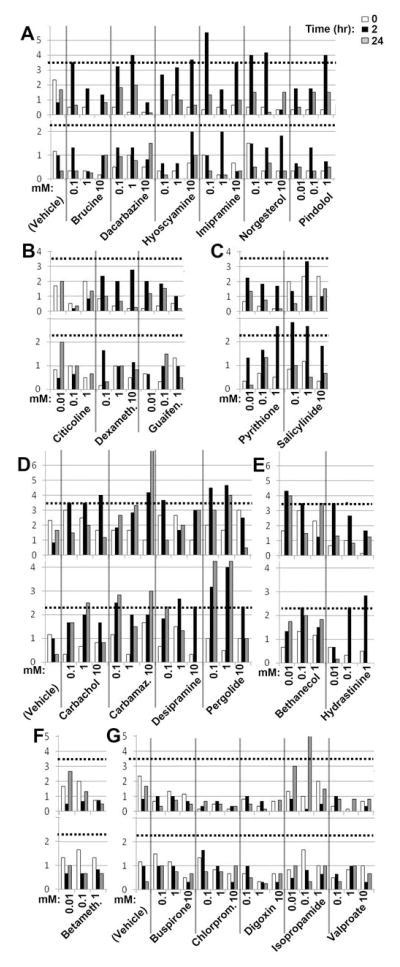Figure 3. Validation assays.
(A–C) Putative DVMAT independent drugs. 6 drugs stimulated locomotion in the weak expressor (A, top panel) but not the null (A, bottom panel) confirming DVMAT dependence. B) 3 failed to stimulate locomotion in either genotype. (C) 2 showed minimal activity in the weak expressor (C, top) but stimulated locomotion in the null (C, bottom, see text). (D–G) Validation of putative DVMAT independent drugs. 4 drugs stimulated locomotion in the weak expressor (D, top) and null (D, bottom) confirming DVMAT independence. Two drugs originally classified as DVMAT dependent stimulated locomotion in both the weak expressor (E, top panel) and the null (E) and were reclassified as DVMAT independent. (F) Betamethasone failed to stimulate locomotion was discarded. (G) Retesting “weak hits”. One drug (isopropamide) activated locomotion in the weak expressor (G, top) but not the null (G) and was classified as DVMAT dependent. Drugs were tested at two concentrations above the minimum that was effective in the primary and secondary screens: 10um, 100um and 1 mM or 100uM, 1mM and 10mM as indicated. Dotted line: cut-off for validated hits (3 SD above the mean at time 0 for all drugs tested in the weak expressor during the validation phase (3.6 grid lines/2 min), or 4 SD above mean at time 0 for all drugs tested in the null during the validation phase (2.2 grid lines/2 min). Abbreviations: Carbamaz., Carbamazepine; Dexameth., Dexamethasone.; Guaifen, Guaifenesin; Betameth., Betamethasone; Chlorprom., Chlorpromazine.

